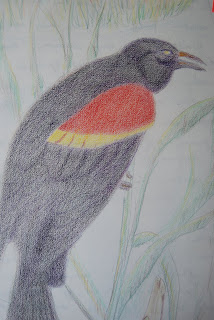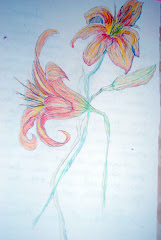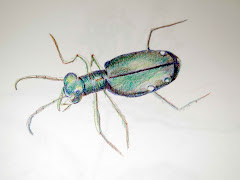


As I set out on the water this day I see many signs of fall around me: bushes ripe with berries everywhere (here, honeysuckle) beautiful goldenrod in bloom (on which I found an amazing yellow and black argiope spider!) and of course, the twice-a-year gathering of redwinged blackbirds. I have yet to write down the date that I’ve first perceived their absence, so I am unsure when to expect their departure. I have a large dead oak, about 45 feet high, and they often congregate here. It seems to be mostly the young males, they look like the females (sort of like a large sparrow, with mottled brown feathers) except they are plumper, and their feathers seem more puffed out. The adult males, of course, are the classic glossy black birds with bright red shoulder patches.
They produce 2-3 broods per year, so that explains all the juveniles so late in the season. They nest on the ground, making a small, tight cup of marsh grass, which is attached to marsh vegetation, or, sometimes, in a bush. The eggs are a beautiful pale blue with dark brown and purple markings.
They have a bad reputation with farmers, as they eat grain in cultivated fields, but actually they benefit the farmer, for they consume large numbers of harmful insects, along with small fruits, small aquatic life, and seeds.
I came around the bend into the brook just as the blackbirds were roosting for the night. Such a cacophonous noise! They excitedly filled the trees and the reeds near the water. They typically gather in huge flocks, so this was not unusual. Little by little, they began to quiet down, settling into the trees, and the long grasses and reeds, as well, for the night.
Within ten minutes there was much less flitting from tree to tree and the chattering began to quiet as well. I noted that the trees they selected still had sunlight falling on them, while the surrounding ones were in shade. Within another five minutes they were almost quiet; there was still some jockeying for position going on, as though they must vie for position anew each night.
I read yesterday that they will gather with other species of blackbirds and even grackles and cowbirds as they prepare to migrate. There is a great explosion of sound and excited behavior that has them gathering in the trees above ones head. This is an amazing thing to witness, especially when some unseen cue silences them all simultaneously!





No comments:
Post a Comment